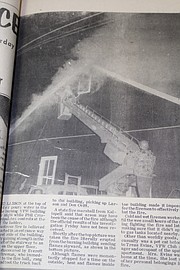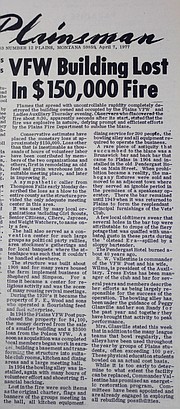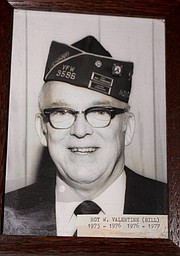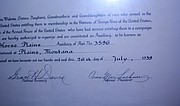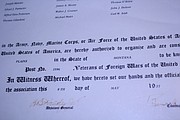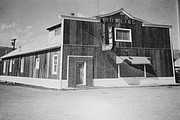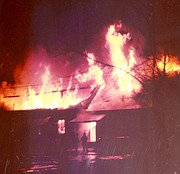Plains VFW fire recalled 40 years later
Four decades ago, the fire that burned VFW Post 3596 changed the community of Plains. The fire may have began around 8:30 p.m. on Mar. 31, 1977. The newspaper at that time, “The Plainsman,” covered the fire on the front page. The initial findings from the Kalispell fire marshal indicated that the fire might have been caused by arson. There were two black and white photos, one showing Leonard Larson and Phil Crismore fighting the fire. There were several things lost in the fire. The losses included many of the belongings and one cat belonging to Tress Evins, who was a bartender there and lived in the apartment above the VFW. Fortunately she was not at home when the fire began. There was a long history to the original VFW building that went back to 1949, when the property was purchased for $4,100. The money was raised from the sale of a small building and a $3,500 loan from the Polson VFW. One very large piece of history that was lost had dated back to 1904. It was a Brunswick bar and back bar that was once part of the old Pendergast Hotel in Plains, which was located on Main Street. The mahogany fixtures once were in another town during the years of Prohibition in the 1930s. Once Prohibition was repealed, the bar and back bar were returned to the VFW. There was a six-lane bowling alley in the basement, where many went during the cold winter months. The fire changed the meeting locations for many groups and organizations; the Girl Scouts, Senior Citizens, CBers, Jaycees, and Weight Watchers.
The current Commander of the Plains VFW Post 3596 is Doug Browning, who had three framed photos of the original building that have been hanging on the walls at the post. One is an undated black and white photo showing how the exterior of the building looked many years before the fire. Browning spoke about the color photos of the fire and his recollection of the historic event.
“The two color photos of the fire have been hanging in an office at the post for many years. I was one year old then when it burnt down,” he said.
Glen Rummel is a VFW member and retired educator who was there the night the building had burned. He spoke about helping other members pull out several things from the burning building.
“We opened the back door of the club and packed out the parade stuff; helmet liners, rifles, and the flags. We also saved the post charter, the Auxiliary Charter, and the World War I banner. The cash register that was on the bar was also saved. The fire was getting much worse and the fire department stopped us from going back in for anything more. The floor was red hot and I saw it fall into the basement, on top of the bowling alley. By then the fire was out of control.”
According to The Plainsman article dated Apr. 7, 1977, the “heat and flames inside the building made it impossible for the firemen to combat the fire.”
Phil Crismore was employed by the Montana Power Company and had a ladder truck that could be extended to the entry door in the attic. He was operating the controls of the ladder, while Leonard Larson held a fire hose at the top of the ladder. Crismore looked at the original black and white photo and article that were printed in “The Plainsman” 40 years ago and recalled that night.
“What took place was I had to kill the power,” he said. “I got the ladder truck and put Leonard in the bucket. When he opened that door we saw that attic was insulated with sawdust and it was a big red glow. When he sprayed the water in there it created steam and ashes that went everywhere. That then opened up an oxygen supply for the fire. When they realized the VFW was a loss they were concerned about the above ground tanks owned by Bob Waters across from there. They were full of fuel, mostly gas and diesel. I was there all night and could not restore the power until the fire had burned out. This was the back of the building. I was able to shut down this section of town, which was from where the Grainery is on Airport Road to just this side of the sawmill (Diehl Mill). It was about 10 to 12 blocks that were without power. Paradise was out of power for an hour, I had switched it over then and kept the power on for the sawmill. I don’t recall if Leonard was on the fire department or if he just happened to be there.”
Leonard Larson was at the VFW fire and climbed the ladder seen in the photo to pour water into the building as the fire was raging. He spoke about that night four decades later while looking at original photos and article in “The Plainsman.”
“That is the window I stuck my head into there and I got into trouble,” Larson said. “I sucked something into my lung and it is still there now. I had it x-rayed and they said it was encapsulated. They have no idea what it is in there. That is the only thing I think could have caused it to be in the lung. I was on the fire department then. I wasn’t up on that ladder in the bucket for very long as I got a face full of smoke. I had to get out of there. Whatever I sucked into my lung made me very sick then and for days afterwards. I remember there was one apartment on the other end and I think this end was just a wall, part of a floor and that window. I think the fire may have started upstairs. I do know that everyone was very worried about those above ground tanks of fuel that Bob Waters owned across the street. We poured water on them and I don’t know if it helped or not, as it didn’t seem like they were getting very hot.”
In 1977 the Commander of the VFW was Roy W. Valentine (known as Bill), and the members had begun discussing and exploring the rebuilding options one-week later (see the reprint of the news item that ran in “The Plainsman” on April 7, 1977, one week after the fire). Charles (Ole) Oeschlager had some information on the VFW fire that had been collected by himself and Don Brown. The information was from newpaper clippings when the fire happened and months afterwards. Oeschlager shared some of his own memories of the event.
“I don’t ever remember reading or hearing about what caused the fire,” he said. “I do know that the insurance company paid the post some money to help us rebuild. I was around to help build the new building. Others were around more and it was finished in the fall of that year.”
The six months after the fire, there was a weekly progress on the rebuilding of the VFW in the paper, written by Mike Scott. At times, the progress report would comment on some of the speed used in knocking down what rubble remained after the fire and the use of various hand tools, cranes, and other heavy equipment to demolish several very large and old concrete slabs that were once part of the structure that held meetings and events. The new VFW building progress moved along until late October, when the grand opening of the new VFW was held.
Reporter Douglas Wilks can be reached at dwilks@vp-mi.com or 406-826-3402.









